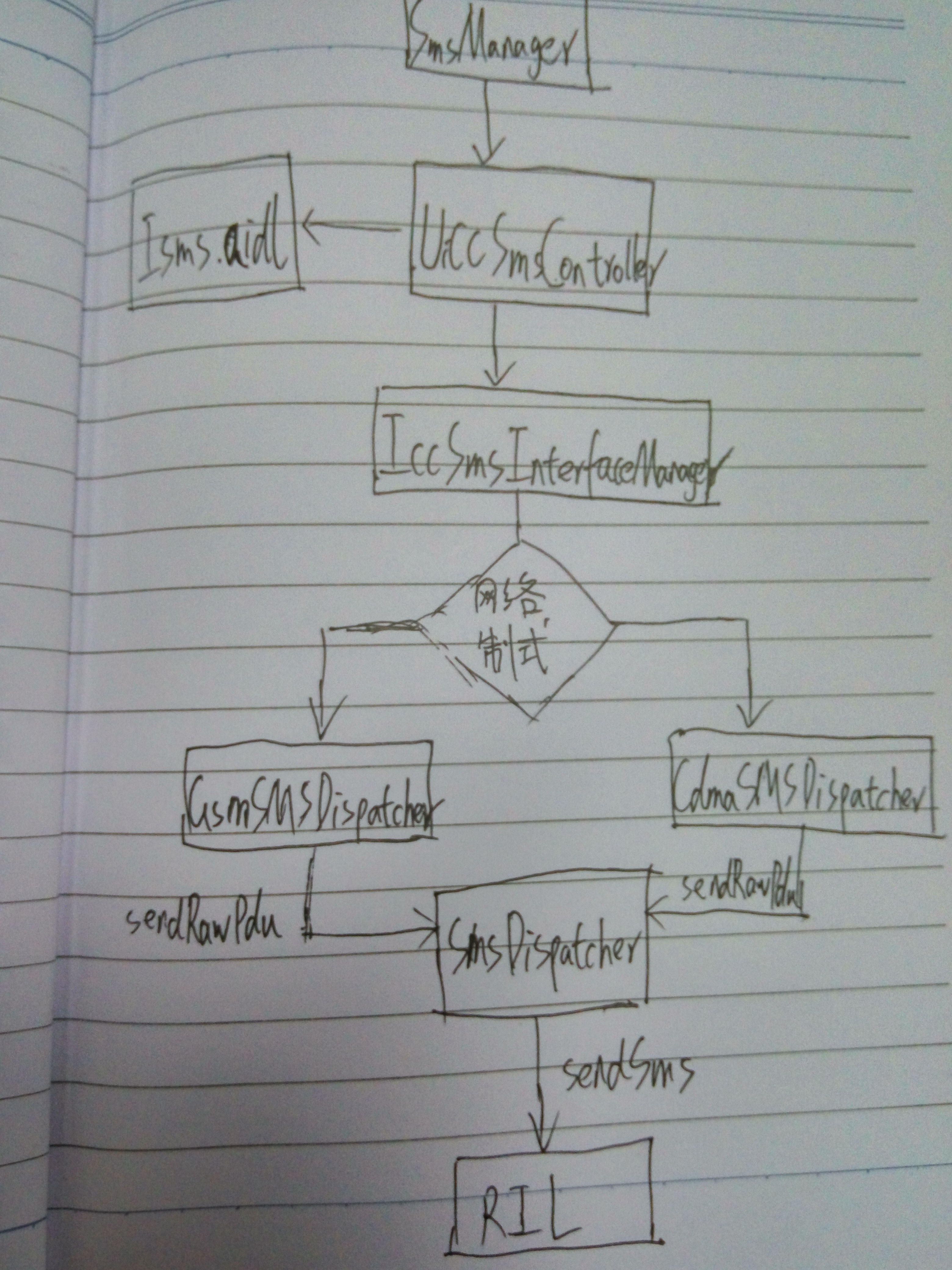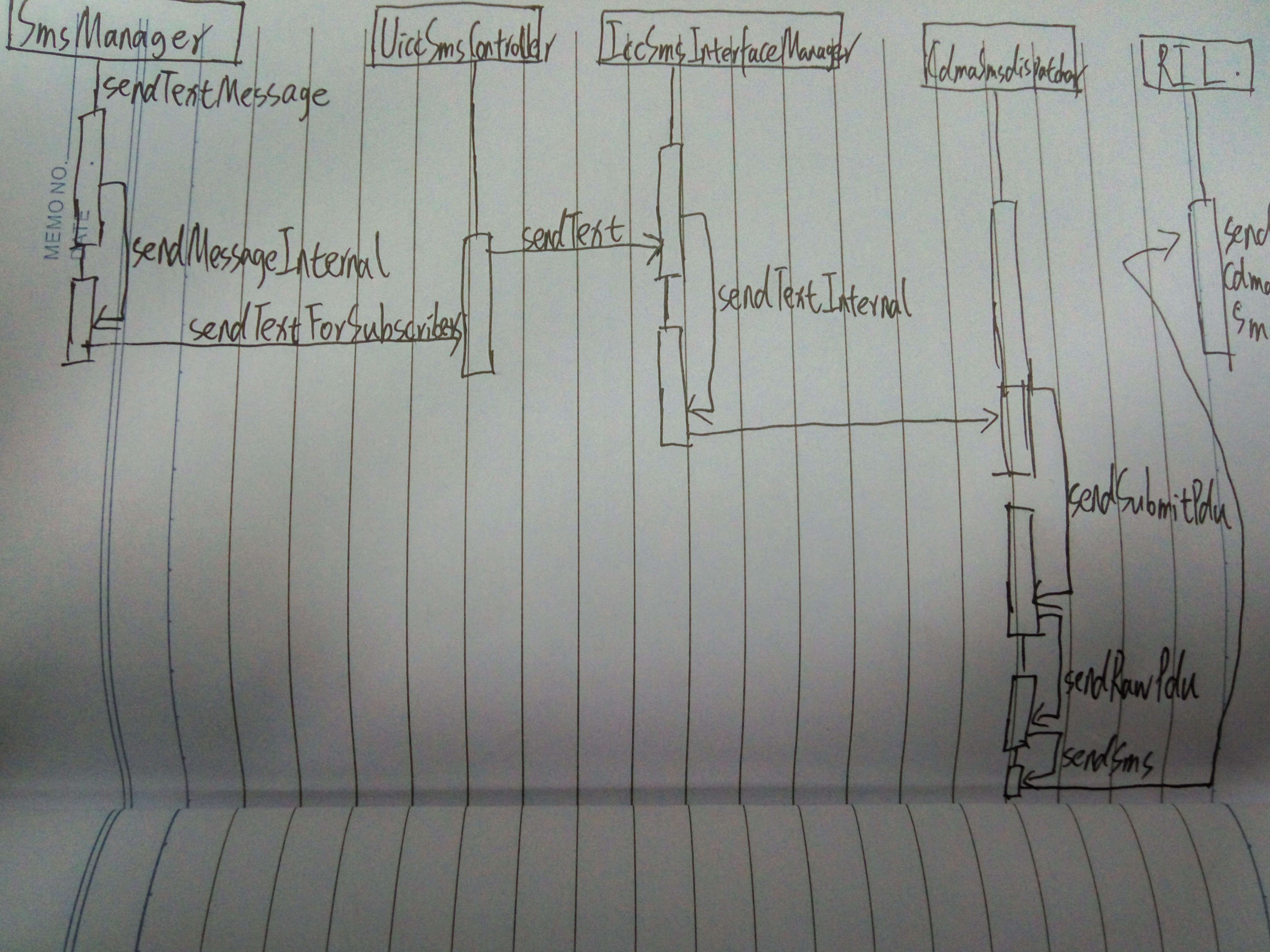在android中,google为开发者提供了一个SmsManager用来管理发送和接收短信的类,类似于WifiManager,先看下SmsManager的常用API
SmsManager常用API
method public java.util.ArrayList<java.lang.String> divideMessage(java.lang.String);一条短信只可容纳70个中文,所以当短信长度超过70个中文字符时程序就要特殊处理了,该方式有个弊端就是用户会分条收到短信。
if (message.length() > 70) {
ArrayList<String> msgs = sms.divideMessage(message);
for (String msg : msgs) {
sms.sendTextMessage(phoneNumber, null, msg, sentPI, deliverPI);
}
}else {
sms.sendTextMessage(phoneNumber, null, message, sentPI, deliverPI);
}
通过sendMultipartTextMessage()方法发送超长短信,这种方式还是发送多条短信,但用户收到的短信会是连在一起的一整条。
if (message.length() > 70) {
ArrayList<String> msgs = sms.divideMessage(message);
ArrayList<PendingIntent> sentIntents =
new ArrayList<PendingIntent>();
for(int i = 0;i<msgs.size();i++){
sentIntents.add(sentPI);
}
sms.sendMultipartTextMessage(phoneNumber, null, msgs, sentIntents, null);
} else {
sms.sendTextMessage(phoneNumber, null, message, sentPI, deliverPI);
}
下载彩信
method public void downloadMultimediaMessage(android.content.Context, java.lang.String, android.net.Uri, android.os.Bundle, android.app.PendingIntent);获取一个SmsManager,该SmsManager和默认的subid关联在一起
method public static android.telephony.SmsManager getDefault()获取默认的subid
method public static int getDefaultSmsSubscriptionId();获取和指定subid关联在一起的SmsManager对象
method public static android.telephony.SmsManager getSmsManagerForSubscriptionId(int);getSubscriptionId,是不是获取当前指定的simcard id,如果是双卡设备,用户没有设置默认的接收短信sim卡,则会跳转到SimDialogActivity,选择默认的接收短信subid
method public int getSubscriptionId();发送短信的方法
method public void sendDataMessage(java.lang.String, java.lang.String, short, byte[], android.app.PendingIntent, android.app.PendingIntent);发送一条彩信
method public void sendMultimediaMessage(android.content.Context, android.net.Uri, java.lang.String, android.os.Bundle, android.app.PendingIntent);发送通过divideMessage分割后的长短信
method public void sendMultipartTextMessage(java.lang.String, java.lang.String, java.util.ArrayList<java.lang.String>, java.util.ArrayList<android.app.PendingIntent>, java.util.ArrayList<android.app.PendingIntent>);发送一条短信
method public void sendTextMessage(java.lang.String, java.lang.String, java.lang.String, android.app.PendingIntent, android.app.PendingIntent);短信的发送流程
短信啊的发送从sendTextMessage 开始
需要申请”android.permission.SEND_SMS”;权限
destinationAddress
发送的目标号码
scAddress
中心号码,该号码不对时候,会出现发送短信失败,但是不影响接收短信
sentIntent
deliveryIntent
发送短信成功或者失败的时候会发送该pendingIntent对应的广播
deliveryIntent
目标号码接收短信成功或者失败的时候会发送该pendingIntent对应的广播
public void sendTextMessage(
String destinationAddress, String scAddress, String text,
PendingIntent sentIntent, PendingIntent deliveryIntent) {
android.util.SeempLog.record_str(75, destinationAddress);
sendTextMessageInternal(destinationAddress, scAddress, text,
sentIntent, deliveryIntent, true /* persistMessageForCarrierApp*/);
}进一步调用sendTextMessageInternal
private void sendTextMessageInternal(String destinationAddress, String scAddress,
String text, PendingIntent sentIntent, PendingIntent deliveryIntent,
boolean persistMessageForCarrierApp) {
// 检查目标号码是否为空
if (TextUtils.isEmpty(destinationAddress)) {
throw new IllegalArgumentException("Invalid destinationAddress");
}
// 检查短信内容是否为空
if (TextUtils.isEmpty(text)) {
throw new IllegalArgumentException("Invalid message body");
}
try {
ISms iccISms = getISmsServiceOrThrow();
iccISms.sendTextForSubscriber(getSubscriptionId(), ActivityThread.currentPackageName(),
destinationAddress,
scAddress, text, sentIntent, deliveryIntent,
persistMessageForCarrierApp);
} catch (RemoteException ex) {
// ignore it
}
}
private static ISms getISmsServiceOrThrow() {
ISms iccISms = getISmsService();
if (iccISms == null) {
throw new UnsupportedOperationException("Sms is not supported");
}
return iccISms;
}
private static ISms getISmsService() {
return ISms.Stub.asInterface(ServiceManager.getService("isms"));
}这里getISmsServiceOrThrow()获取的是一个ISms服务UiccSmsController,UiccSmsController继承自ISms.Stub
frameworks/opt/telephony/src/java/com/android/internal/telephony/UiccSmsController.java
isms service是在UiccSmsController构造方法中添加的
protected UiccSmsController(Phone[] phone){
mPhone = phone;
if (ServiceManager.getService("isms") == null) {
ServiceManager.addService("isms", this);
}
}
UiccSmsController#sendTextForSubscriber
@Override
public void sendTextForSubscriber(int subId, String callingPackage, String destAddr,
String scAddr, String text, PendingIntent sentIntent, PendingIntent deliveryIntent,
boolean persistMessageForNonDefaultSmsApp) {
// 获取具有该subId对应的phone的IccSmsInterfaceManager对象
IccSmsInterfaceManager iccSmsIntMgr = getIccSmsInterfaceManager(subId);
if (iccSmsIntMgr != null) {
iccSmsIntMgr.sendText(callingPackage, destAddr, scAddr, text, sentIntent,
deliveryIntent, persistMessageForNonDefaultSmsApp);
} else {
Rlog.e(LOG_TAG,"sendTextForSubscriber iccSmsIntMgr is null for" +
" Subscription: " + subId);
sendErrorInPendingIntent(sentIntent, SmsManager.RESULT_ERROR_GENERIC_FAILURE);
}
}可以看到上面首先获取具有该subId对应的phone的IccSmsInterfaceManager对象,然后通过IccSmsInterfaceManager#sendText进一步发送短信
private @Nullable IccSmsInterfaceManager getIccSmsInterfaceManager(int subId) {
// 当前subId不可用,用户没有激活
if (!isActiveSubId(subId)) {
return null;
}
int phoneId = SubscriptionController.getInstance().getPhoneId(subId) ;
//Fixme: for multi-subscription case
if (!SubscriptionManager.isValidPhoneId(phoneId)
|| phoneId == SubscriptionManager.DEFAULT_PHONE_INDEX) {
phoneId = 0;
}
try {
// mPhone是在PhoneFactory中初始化并赋值的,Phone是一个接口,具体实现是在PhoneProxy中
return (IccSmsInterfaceManager)
((PhoneProxy)mPhone[(int)phoneId]).getIccSmsInterfaceManager();
} catch (NullPointerException e) {
Rlog.e(LOG_TAG, "Exception is :"+e.toString()+" For subscription :"+subId );
e.printStackTrace();
return null;
} catch (ArrayIndexOutOfBoundsException e) {
Rlog.e(LOG_TAG, "Exception is :"+e.toString()+" For subscription :"+subId );
e.printStackTrace();
return null;
}
}
小插曲phone的初始化
从上面的代码可以看到phone是一个很重要的对象,其对于发送短信是不可或缺的,关于phone对象初始化是从PhoneFactory开始的
frameworks/opt/telephony/src/java/com/android/internal/telephony/PhoneFactory.java
public class PhoneFactory {
....
static private PhoneProxy[] sProxyPhones = null;
public static void makeDefaultPhones(Context context) {
makeDefaultPhone(context);
}
/**
* FIXME replace this with some other way of making these
* instances
*/
public static void makeDefaultPhone(Context context) {
synchronized (sLockProxyPhones) {
if (!sMadeDefaults) {
....
sContext = context;
int numPhones = TelephonyManager.getDefault().getPhoneCount();
int[] networkModes = new int[numPhones];
// 1. 为sProxyPhones数组初始化
sProxyPhones = new PhoneProxy[numPhones];
// 初始化sCommandsInterfaces
sCommandsInterfaces = new RIL[numPhones];
for (int i = 0; i < numPhones; i++) {
try {
networkModes[i]
= TelephonyManager.getIntAtIndex(
context.getContentResolver(),
Settings.Global.PREFERRED_NETWORK_MODE , i);
} catch (SettingNotFoundException snfe) {
networkModes[i] = RILConstants.PREFERRED_NETWORK_MODE;
}
// 为sCommandsInterfaces赋值,最终发送短信其实就是通过RIL实现的
sCommandsInterfaces[i] = new RIL(context, networkModes[i],
cdmaSubscription, i);
}
// Instantiate UiccController so that all other classes can just
// call getInstance()
mUiccController = UiccController.make(context, sCommandsInterfaces);
for (int i = 0; i < numPhones; i++) {
PhoneBase phone = null;
int phoneType = TelephonyManager.getPhoneType(networkModes[i]);
if (phoneType == PhoneConstants.PHONE_TYPE_GSM) {
phone = TelephonyPluginDelegate.getInstance().makeGSMPhone(context,
sCommandsInterfaces[i], sPhoneNotifier, i);
} else if (phoneType == PhoneConstants.PHONE_TYPE_CDMA) {
phone = TelephonyPluginDelegate.getInstance().makeCDMALTEPhone(context,
sCommandsInterfaces[i], sPhoneNotifier, i);
}
// 2. 为sProxyPhones赋值,这里是Phone接口的实现类,PhoneProxy
sProxyPhones[i] = TelephonyPluginDelegate.getInstance().makePhoneProxy(phone);
}
mProxyController = ProxyController.getInstance(context, sProxyPhones,
mUiccController, sCommandsInterfaces);
// Set the default phone in base class.
// FIXME: This is a first best guess at what the defaults will be. It
// FIXME: needs to be done in a more controlled manner in the future.
sProxyPhone = sProxyPhones[0];
sCommandsInterface = sCommandsInterfaces[0];
// Default phone must be ready before ImsPhone is created
// because ImsService might need it when it is being opened.
for (int i = 0; i < numPhones; i++) {
sProxyPhones[i].startMonitoringImsService();
}
}
}
}
....
}
可以看到关于phone的初始化是在PhoneFactory#makeDefaultPhone中进行的,那么makeDefaultPhone其实是在PhoneGlobals#onCreate调用的呦。
packages/services/Telephony/src/com/android/phone/PhoneGlobals.java
public class PhoneGlobals extends ContextWrapper {
if (mCM == null) {
// 初始化phone数组
PhoneFactory.makeDefaultPhones(this);
// Start TelephonyDebugService After the default phone is created.
Intent intent = new Intent(this, TelephonyDebugService.class);
startService(intent);
mCM = CallManager.getInstance();
for (Phone phone : PhoneFactory.getPhones()) {
// 注册当前phone
mCM.registerPhone(phone);
}
// Create the NotificationMgr singleton, which is used to display
// status bar icons and control other status bar behavior.
notificationMgr = NotificationMgr.init(this);
mHandler.sendEmptyMessage(EVENT_START_SIP_SERVICE);
// Create an instance of CdmaPhoneCallState and initialize it to IDLE
cdmaPhoneCallState = new CdmaPhoneCallState();
cdmaPhoneCallState.CdmaPhoneCallStateInit();
// before registering for phone state changes
mPowerManager = (PowerManager) getSystemService(Context.POWER_SERVICE);
mWakeLock = mPowerManager.newWakeLock(PowerManager.FULL_WAKE_LOCK, LOG_TAG);
// lock used to keep the processor awake, when we don't care for the display.
mPartialWakeLock = mPowerManager.newWakeLock(PowerManager.PARTIAL_WAKE_LOCK
| PowerManager.ON_AFTER_RELEASE, LOG_TAG);
mKeyguardManager = (KeyguardManager) getSystemService(Context.KEYGUARD_SERVICE);
// get a handle to the service so that we can use it later when we
// want to set the poke lock.
mPowerManagerService = IPowerManager.Stub.asInterface(
ServiceManager.getService("power"));
// Get UpdateLock to suppress system-update related events (e.g. dialog show-up)
// during phone calls.
mUpdateLock = new UpdateLock("phone");
if (DBG) Log.d(LOG_TAG, "onCreate: mUpdateLock: " + mUpdateLock);
CallLogger callLogger = new CallLogger(this, new CallLogAsync());
callGatewayManager = CallGatewayManager.getInstance();
// Create the CallController singleton, which is the interface
// to the telephony layer for user-initiated telephony functionality
// (like making outgoing calls.)
callController = CallController.init(this, callLogger, callGatewayManager);
// Create the CallerInfoCache singleton, which remembers custom ring tone and
// send-to-voicemail settings.
//
// The asynchronous caching will start just after this call.
callerInfoCache = CallerInfoCache.init(this);
// Monitors call activity from the telephony layer
callStateMonitor = new CallStateMonitor(mCM);
phoneMgr = PhoneInterfaceManager.init(this, PhoneFactory.getDefaultPhone());
configLoader = CarrierConfigLoader.init(this);
// Create the CallNotifer singleton, which handles
// asynchronous events from the telephony layer (like
// launching the incoming-call UI when an incoming call comes
// in.)
notifier = CallNotifier.init(this, callLogger, callStateMonitor);
PhoneUtils.registerIccStatus(mHandler, EVENT_SIM_NETWORK_LOCKED);
// register for MMI/USSD
mCM.registerForMmiComplete(mHandler, MMI_COMPLETE, null);
// register connection tracking to PhoneUtils
PhoneUtils.initializeConnectionHandler(mCM);
// 注册监听对应的广播
IntentFilter intentFilter =
new IntentFilter(Intent.ACTION_AIRPLANE_MODE_CHANGED);
intentFilter.addAction(TelephonyIntents.ACTION_ANY_DATA_CONNECTION_STATE_CHANGED);
intentFilter.addAction(TelephonyIntents.ACTION_SIM_STATE_CHANGED);
intentFilter.addAction(TelephonyIntents.ACTION_RADIO_TECHNOLOGY_CHANGED);
intentFilter.addAction(TelephonyIntents.ACTION_SERVICE_STATE_CHANGED);
intentFilter.addAction(TelephonyIntents.ACTION_EMERGENCY_CALLBACK_MODE_CHANGED);
registerReceiver(mReceiver, intentFilter);
//set the default values for the preferences in the phone.
PreferenceManager.setDefaultValues(this, R.xml.network_setting, false);
PreferenceManager.setDefaultValues(this, R.xml.call_feature_setting, false);
// Make sure the audio mode (along with some
// audio-mode-related state of our own) is initialized
// correctly, given the current state of the phone.
PhoneUtils.setAudioMode(mCM);
}
....
}
}接上面IccSmsInterfaceManager.sendText
public void sendText(String callingPackage, String destAddr, String scAddr,
String text, PendingIntent sentIntent, PendingIntent deliveryIntent,
boolean persistMessageForNonDefaultSmsApp) {
// 检查当前应用包是否具有Manifest.permission.SEND_SMS权限,如果没有则抛出一个SecurityException
mPhone.getContext().enforceCallingPermission(
Manifest.permission.SEND_SMS,
"Sending SMS message");
sendTextInternal(callingPackage, destAddr, scAddr, text, sentIntent, deliveryIntent,
persistMessageForNonDefaultSmsApp);
}
private void sendTextInternal(String callingPackage, String destAddr, String scAddr,
String text, PendingIntent sentIntent, PendingIntent deliveryIntent,
boolean persistMessageForNonDefaultSmsApp) {
if (Rlog.isLoggable("SMS", Log.VERBOSE)) {
log("sendText: destAddr=" + destAddr + " scAddr=" + scAddr +
" text='"+ text + "' sentIntent=" +
sentIntent + " deliveryIntent=" + deliveryIntent);
}
if (!isAllowedToSendMsgByPolicy()) {
if (sentIntent != null) {
try {
sentIntent.send(SmsManager.RESULT_ERROR_GENERIC_FAILURE);
} catch (CanceledException ce) {
}
}
return;
}
if (mAppOps.noteOp(AppOpsManager.OP_SEND_SMS, Binder.getCallingUid(),
callingPackage) != AppOpsManager.MODE_ALLOWED) {
return;
}
if (!persistMessageForNonDefaultSmsApp) {
// Only allow carrier app to skip auto message persistence.
enforceCarrierPrivilege();
}
destAddr = filterDestAddress(destAddr);
// mDispatcher是SMSDispatcher类型,具体实现类是ImsSMSDispatcher
mDispatcher.sendText(destAddr, scAddr, text, sentIntent, deliveryIntent,
null/*messageUri*/, callingPackage, persistMessageForNonDefaultSmsApp,
-1, false, -1);
}通过判断网络制式,分别调用GsmSMSDispatcher和CdmaSMSDispatcher的sendText()方法。
@Override
protected void sendText(String destAddr, String scAddr, String text, PendingIntent sentIntent,
PendingIntent deliveryIntent, Uri messageUri, String callingPkg,
boolean persistMessage, int priority, boolean isExpectMore, int validityPeriod) {
Rlog.d(TAG, "sendText");
if (isCdmaMo()) {
mCdmaDispatcher.sendText(destAddr, scAddr,
text, sentIntent, deliveryIntent, messageUri, callingPkg, persistMessage,
priority, isExpectMore, validityPeriod);
} else {
mGsmDispatcher.sendText(destAddr, scAddr,
text, sentIntent, deliveryIntent, messageUri, callingPkg, persistMessage,
priority, isExpectMore, validityPeriod);
}
}以CdmaSMSDispatcher为例
@Override
protected void sendText(String destAddr, String scAddr, String text, PendingIntent sentIntent,
PendingIntent deliveryIntent, Uri messageUri, String callingPkg,
boolean persistMessage, int priority, boolean isExpectMore, int validityPeriod) {
// 将当前的参数封装成pdu
SmsMessage.SubmitPdu pdu = SmsMessage.getSubmitPdu(
scAddr, destAddr, text, (deliveryIntent != null), null, priority);
if (pdu != null) {
HashMap map = getSmsTrackerMap(destAddr, scAddr, text, pdu);
// 根据封装后的pdu,获取一个SmsTracker
SmsTracker tracker = getSmsTracker(callingPkg, map, sentIntent, deliveryIntent,
getFormat(), messageUri, isExpectMore, text, true /*isText*/, validityPeriod,
persistMessage);
String carrierPackage = getCarrierAppPackageName();
if (carrierPackage != null) {
TextSmsSender smsSender = new TextSmsSender(tracker);
smsSender.sendSmsByCarrierApp(carrierPackage, new SmsSenderCallback(smsSender));
} else {
// 通过sendSubmitPdu进一步发送短信,在sendSubmitPdu中会调用sendRawPdu(tracker);
sendSubmitPdu(tracker);
}
} else {
if (sentIntent != null) {
try {
sentIntent.send(SmsManager.RESULT_ERROR_GENERIC_FAILURE);
} catch (CanceledException ex) {
Rlog.e(TAG, "Intent has been canceled!");
}
}
}
}
@Override
protected void sendSubmitPdu(SmsTracker tracker) {
if (SystemProperties.getBoolean(TelephonyProperties.PROPERTY_INECM_MODE, false)) {
if (VDBG) {
Rlog.d(TAG, "Block SMS in Emergency Callback mode");
}
tracker.onFailed(mContext, SmsManager.RESULT_ERROR_NO_SERVICE, 0/*errorCode*/);
return;
}
// sendRawPdu是父类SMSDispatcher的方法
sendRawPdu(tracker);
}
SMSDispatcher#sendRawPdu
protected void sendRawPdu(SmsTracker tracker) {
HashMap map = tracker.mData;
// 获取pdu
byte pdu[] = (byte[]) map.get("pdu");
// 是否可以发送短信
if (mSmsSendDisabled) {
Rlog.e(TAG, "Device does not support sending sms.");
tracker.onFailed(mContext, RESULT_ERROR_NO_SERVICE, 0/*errorCode*/);
return;
}
// pdu是否为空
if (pdu == null) {
Rlog.e(TAG, "Empty PDU");
tracker.onFailed(mContext, RESULT_ERROR_NULL_PDU, 0/*errorCode*/);
return;
}
// Get calling app package name via UID from Binder call
PackageManager pm = mContext.getPackageManager();
String[] packageNames = pm.getPackagesForUid(Binder.getCallingUid());
if (packageNames == null || packageNames.length == 0) {
// Refuse to send SMS if we can't get the calling package name.
Rlog.e(TAG, "Can't get calling app package name: refusing to send SMS");
tracker.onFailed(mContext, RESULT_ERROR_GENERIC_FAILURE, 0/*errorCode*/);
return;
}
// Get package info via packagemanager
PackageInfo appInfo;
try {
// XXX this is lossy- apps can share a UID
appInfo = pm.getPackageInfo(packageNames[0], PackageManager.GET_SIGNATURES);
} catch (PackageManager.NameNotFoundException e) {
Rlog.e(TAG, "Can't get calling app package info: refusing to send SMS");
tracker.onFailed(mContext, RESULT_ERROR_GENERIC_FAILURE, 0/*errorCode*/);
return;
}
// checkDestination() returns true if the destination is not a premium short code or the
// sending app is approved to send to short codes. Otherwise, a message is sent to our
// handler with the SmsTracker to request user confirmation before sending.
if (checkDestination(tracker)) {
// check for excessive outgoing SMS usage by this app
if (!mUsageMonitor.check(appInfo.packageName, SINGLE_PART_SMS)) {
sendMessage(obtainMessage(EVENT_SEND_LIMIT_REACHED_CONFIRMATION, tracker));
return;
}
// 通过CdmaSMSDispatcher.sendSms(tracker)发送短信
sendSms(tracker);
}
}
- 获取pdu
- 判断是否可以发送短信
- 判断pdu是否为空
- 通过CdmaSMSDispatcher.sendSms(tracker)发送短信
@Override
protected void sendSms(SmsTracker tracker) {
HashMap<String, Object> map = tracker.mData;
// byte[] smsc = (byte[]) map.get("smsc");
// unused for CDMA
byte[] pdu = (byte[]) map.get("pdu");
Rlog.d(TAG, "sendSms: "
+ " isIms()=" + isIms()
+ " mRetryCount=" + tracker.mRetryCount
+ " mImsRetry=" + tracker.mImsRetry
+ " mMessageRef=" + tracker.mMessageRef
+ " SS=" + mPhone.getServiceState().getState());
sendSmsByPstn(tracker);
}
@Override
protected void sendSmsByPstn(SmsTracker tracker) {
int ss = mPhone.getServiceState().getState();
// if sms over IMS is not supported on data and voice is not available...
if (!isIms() && ss != ServiceState.STATE_IN_SERVICE) {
tracker.onFailed(mContext, getNotInServiceError(ss), 0/*errorCode*/);
return;
}
// 构造一个消息,表示发送完成
Message reply = obtainMessage(EVENT_SEND_SMS_COMPLETE, tracker);
byte[] pdu = (byte[]) tracker.mData.get("pdu");
int currentDataNetwork = mPhone.getServiceState().getDataNetworkType();
boolean imsSmsDisabled = (currentDataNetwork == TelephonyManager.NETWORK_TYPE_EHRPD
|| (mPhone.getServiceStateTracker().isRatLte(currentDataNetwork)
&& !mPhone.getServiceStateTracker().isConcurrentVoiceAndDataAllowed()))
&& mPhone.getServiceState().getVoiceNetworkType()
== TelephonyManager.NETWORK_TYPE_1xRTT
&& ((CDMAPhone) mPhone).mCT.mState != PhoneConstants.State.IDLE;
if (0 == tracker.mImsRetry && !isIms()) {
mCi.sendCdmaSms(pdu, reply);
}
else if (!mImsSMSDispatcher.isImsSmsEnabled()) {
mCi.sendCdmaSms(pdu, reply);
mImsSMSDispatcher.enableSendSmsOverIms(true);
}
else {
mCi.sendImsCdmaSms(pdu, tracker.mImsRetry, tracker.mMessageRef, reply);
// increment it here, so in case of SMS_FAIL_RETRY over IMS
// next retry will be sent using IMS request again.
tracker.mImsRetry++;
}
}
上面的代码最终是通过mCi的sendCdmaSms或者sendImsCdmaSms进一步发送短信的,mCi是CommandsInterface接口,具体实现类也是在PhoneFactory中和Phone对象一并初始化的,其实就是RIL中,
到现在为止短信的发送流程就结束了。
整体流程
最后
以上就是灵巧泥猴桃最近收集整理的关于短信的发送流程的全部内容,更多相关短信内容请搜索靠谱客的其他文章。










发表评论 取消回复